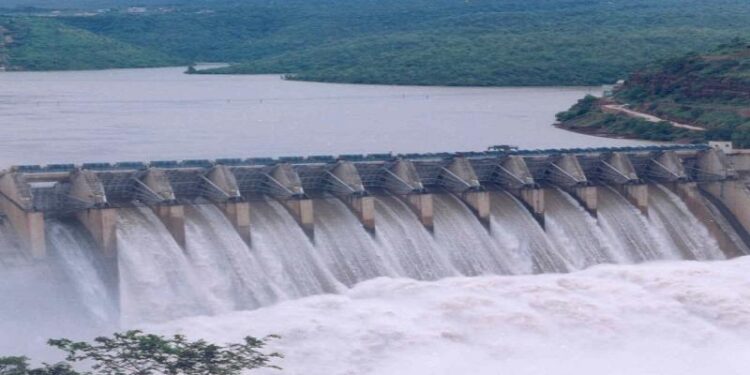
Krishna River Basin: A flood-like situation has emerged across the Krishna River basin following incessant rainfall in Karnataka’s catchment areas. With rising water levels in major rivers and reservoirs, district administrations in Vijayapura and Bagalkot have stepped up relief operations, relocating residents from vulnerable villages to safer locations.
On Wednesday evening, officials at Krishna Bhagya Jal Nigam Ltd (KBJNL) reported that the Almatti dam was discharging around 2.5 lakh cusecs of water, significantly higher than the average inflow of 1.6 lakh cusecs. Authorities fear that if the outflow touches 5 lakh cusecs, low-lying villages like Masuti could face complete submergence.
Heavy Inflow into Dams in Krishna River Basin
According to sources, six Krishna basin dams — Bhadra, Tungabhadra, Ghataprabha, Malaprabha, Almatti, and Narayanpur — collectively received around 20.5 tmcft of water in the last 24 hours due to continuous downpours. In some basins, the discharge has exceeded inflow, raising concerns about worsening flood conditions downstream.
At Rajapur barrage in Jamkhandi taluk, the discharge from the Krishna River was recorded at 1.4 lakh cusecs on Wednesday evening. Meanwhile, Narayanpur dam authorities have warned of a possible surge in inflow, expected to reach 2.6 lakh cusecs by Thursday, which may further increase downstream water release.
Rivers swelling across northern Karnataka
The persistent rains have swollen the Krishna, Ghataprabha, and Malaprabha rivers, inundating agricultural fields and road networks in several villages. Farmers in Mudhol, Jamkhandi, and Bilagi taluks have expressed concern over crop loss as paddy, sugarcane, and maize fields remain submerged under standing water.
Speaking to reporters, Bagalkot Deputy Commissioner Sangappa confirmed that a relief centre has been set up in Mirji village of Mudhol taluk to shelter displaced families. “Our priority is to ensure the safety of residents in low-lying villages. Teams have been deployed to monitor water levels round the clock,” he said.
Rescue and relief operations
Local administrations, in coordination with the State Disaster Response Force (SDRF), have intensified evacuation drives. Residents from flood-prone villages are being shifted to government schools and community halls, temporarily converted into relief shelters. Food packets, blankets, and drinking water are being distributed to the affected families.
Officials said they are keeping a close watch on weather updates, as the Indian Meteorological Department (IMD) has predicted continued rainfall over the Western Ghats and Krishna River basin for the next 48 hours.
Public Safety Measures in Krishna River Basin
Authorities have urged people living near riverbanks to remain vigilant and avoid venturing into swollen rivers. Warning sirens have been installed at several locations near Almatti and Narayanpur dams to alert villagers of sudden releases.
“The situation is under control, but we cannot take chances,” said Shweta MB, Assistant Commissioner, Jamkhandi. “If water discharge increases further, we will have to shift more families to safer areas.”
Flood Management Challenges and the Road Ahead
Experts point out that the Krishna River basin is particularly vulnerable to floods due to heavy rainfall in upstream Maharashtra and Karnataka. The simultaneous release of water from multiple reservoirs often leads to downstream flooding, especially in Bagalkot and Vijayapura districts.
Former irrigation engineers have suggested better dam management policies to regulate inflows and prevent abrupt releases that overwhelm villages. Environmentalists have also emphasized the importance of restoring natural floodplains and wetlands that can absorb excess rainfall.
With the monsoon at its peak, the next few days will be crucial for flood management in the Krishna River basin. Authorities are preparing contingency plans in case of further escalation, including the deployment of additional rescue boats and medical teams.
For now, residents along the Krishna, Ghataprabha, and Malaprabha rivers continue to brace for uncertainty, hoping that rainfall subsides and water levels stabilize before more damage occurs.
















